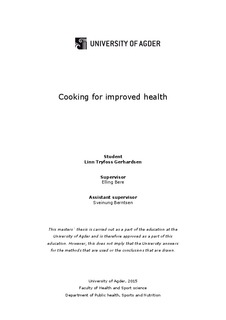| dc.description.abstract | Background/Aims: The fourth largest risk factor for non-communicable diseases and mortality is physical
inactivity. Non-exercise activities, often light in intensity, are frequently grouped with sedentary behavior.
This may be an unmistakable activity, and it involves energy expenditure. Thus, we wanted to examine if
a daily activity like cooking food could reduce time spent in sedentariness or increase time being physical
active. The specific aim of the present study was to determine; (1) to what extent do a cooking
intervention led to increased physical activity, or reduced sedentary time, and (2) is there an association
between degree of cooking and physical activity levels, or sedentary time, in a method study.
Method: Cooking for Improved Health Intervention (CIHI), 15 participants completed an intervention
(there were no control group) and baseline and post intervention measurements. They had to wear a
Physical Activity monitor (PA monitor) for four days both previous and after the intervention. The PA
monitor measured steps per day, sleep per day and hours spent in light, moderate and vigorous intensity.
A paired sample T-test was preformed to check the significant between baseline and post measurements
from the PA monitor. In the method study, Healthy and Sustainable Lifestyle (HSL), 75 participants
completed a questionnaire, and worn a PA monitor for four days. The PA monitor data were divided into
two groups “ little” cooking (cooked for >0-500 minutes a week) and “considerable” cooking (cooked for
>500 minutes a week) and were then run up against sleep, light, moderate and vigorous intensity with a
One-Way ANOVA test.
Results: In CIHI there were no significant increase in physical activity or reduced sedentary time.
In HSL there were no significant association between degree of cooking and physical activity level, or
sedentary time.
Conclusion: We observed no significant associations between cooking and physical activity level or
reduced sedentary time, neither in the intervention (CIHI) or the method (HSL) studies. The researcher is
uncertain why there were no significant discoveries.
Key words: Cooking, intervention, sedentary time, physical activity level | nb_NO |
